|
|

Most of the Monumnets you can visit in Lecce are made in our
local stone and above all in Baroque style which
reaches its pureness in this town. The stately castle of Charles V was built by
himself in 1539 on a pre-existing medieval building. The previous ditches and
the old drawbridges do not exist anymore. Lecce is also rich of several Palaces
such as Castromediano Palace, dating to the 16th century and is considered as
one the oldest of this century. Palmieri Palace (16th century) was restored in
the 18th century. Gorgoni Palace (16th century) has Latin inscriptions and
beautiful Renaissance windows. Giustiniani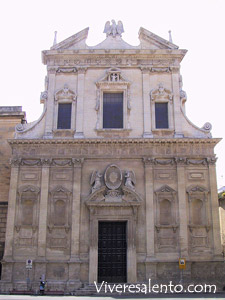 Palace (16th century) was restored in
the 18th century. Holy Spirit Palace (16th century) was an hospital designed by
the Architect Gian Giacomo dell’Acaya. Loffredo-Adorno Palace was built in 1568
by Gabriele Ricciardi and has a beautiful portal. Panzera Palace was built in
the 16th century and restored in the 18th century. Costantini Palace dates to
the 17th century and was restored at the end of the same century by Giuseppe
Cino. Tafuri Palace (17th century) was planned by Giovanni Andrea
Larducci and is considered one of the largest houses of the 18th century.
Paladini Palace (17th century) is one of the masterpieces of Giuseppe Zimbalo.
Martucci Palace and its wonderful portal were made by Giuseppe Cino (17th
century). Gorgoni Palace was built by Emanuele Manieri in the 18th century. Also
the Guarini Palace dates to the 18th century and was built by Manieri. Marrese
Palace dates to the 18th century and its portal was created by Manieri. The
three doors of the town are also very interesting and are still in good
conditions. Naples Door was built in 1548 in honour of the victories and the
splendour of Charles V, it was designed by Gian Giacomo Dell’Acaya. The symbols
of the Spanish empire, the guns and an eagle, have been carved on it. Rudiae
Door dates to the 1703, was probably designed by Giuseppe Cino and is dedicated
Palace (16th century) was restored in
the 18th century. Holy Spirit Palace (16th century) was an hospital designed by
the Architect Gian Giacomo dell’Acaya. Loffredo-Adorno Palace was built in 1568
by Gabriele Ricciardi and has a beautiful portal. Panzera Palace was built in
the 16th century and restored in the 18th century. Costantini Palace dates to
the 17th century and was restored at the end of the same century by Giuseppe
Cino. Tafuri Palace (17th century) was planned by Giovanni Andrea
Larducci and is considered one of the largest houses of the 18th century.
Paladini Palace (17th century) is one of the masterpieces of Giuseppe Zimbalo.
Martucci Palace and its wonderful portal were made by Giuseppe Cino (17th
century). Gorgoni Palace was built by Emanuele Manieri in the 18th century. Also
the Guarini Palace dates to the 18th century and was built by Manieri. Marrese
Palace dates to the 18th century and its portal was created by Manieri. The
three doors of the town are also very interesting and are still in good
conditions. Naples Door was built in 1548 in honour of the victories and the
splendour of Charles V, it was designed by Gian Giacomo Dell’Acaya. The symbols
of the Spanish empire, the guns and an eagle, have been carved on it. Rudiae
Door dates to the 1703, was probably designed by Giuseppe Cino and is dedicated
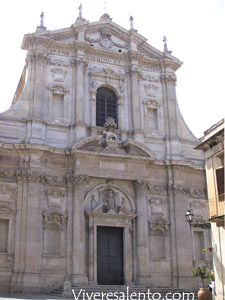 to St Oronzo whose statue is on top of the door. On the two sides there are the
statues of St Domenico and St Irene. St Biagio Door was built in the 18th
century and is dedicated to this saint. The two coat of arms of Lecce have been
engraved on the arch while on top there is a statue of St Biagio. There was also
a fourth door dedicated to St Martino but was completely knocked down in 19th
century. The obelisk is also worth visiting. It was built in 1822 by Vito
Carluccio according
to the will of Ferdinando Bourbon. The Roman amphitheatre dates to the 2nd
century A.C.. It is in the town centre and exactly in St Oronzo’s Square. From
the 16th century on , this structure became unfortunately a kind of foundation
for the building of new houses and only in 1901 Cosimo de Giorgi found it again.
Today we can only see half of it because the other half is underneath the church
of St Mary of the Graces. People think that, when it worked, it could contain
25000 people. The archaeological excavations of 1938 have discovered some
interesting and valuable sculptures, such as ‘The wounded horsewoman’, which can
be visited in the Castromediano Museum. The column of St Oronzo is 29 m tall and
was built in 1656 to thank the saint for his miraculous help against the plague.
It was built by Giuseppe Zimbalo. The Seminar is a wonderful artistic structure
so much that somebody thinks it should be the 8th Beauty of the World. The
building was began in 1694 by Giuseppe Cino and finished in 1709. Many of the
churches of Lecce are real masterpieces as for instance the Cathedral and to St Oronzo whose statue is on top of the door. On the two sides there are the
statues of St Domenico and St Irene. St Biagio Door was built in the 18th
century and is dedicated to this saint. The two coat of arms of Lecce have been
engraved on the arch while on top there is a statue of St Biagio. There was also
a fourth door dedicated to St Martino but was completely knocked down in 19th
century. The obelisk is also worth visiting. It was built in 1822 by Vito
Carluccio according
to the will of Ferdinando Bourbon. The Roman amphitheatre dates to the 2nd
century A.C.. It is in the town centre and exactly in St Oronzo’s Square. From
the 16th century on , this structure became unfortunately a kind of foundation
for the building of new houses and only in 1901 Cosimo de Giorgi found it again.
Today we can only see half of it because the other half is underneath the church
of St Mary of the Graces. People think that, when it worked, it could contain
25000 people. The archaeological excavations of 1938 have discovered some
interesting and valuable sculptures, such as ‘The wounded horsewoman’, which can
be visited in the Castromediano Museum. The column of St Oronzo is 29 m tall and
was built in 1656 to thank the saint for his miraculous help against the plague.
It was built by Giuseppe Zimbalo. The Seminar is a wonderful artistic structure
so much that somebody thinks it should be the 8th Beauty of the World. The
building was began in 1694 by Giuseppe Cino and finished in 1709. Many of the
churches of Lecce are real masterpieces as for instance the Cathedral and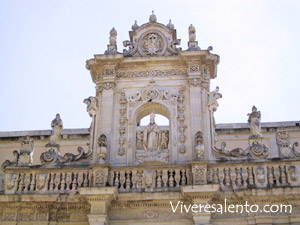 the
Basilica of the St Cross. The cathedral is situated in the homonym square where
there is also the Seminar. Giuseppe Zimbalo restructured it in 1659 according to
the will of the Bishop Pappacoda.
The original building dated to the 1144 and was restored in 1230 according to
the will of the Bishop Volturio. It has a Latin cross plan. The internal altars,
the portal and the façade are richly decorated, there are some important
paintings such as that of ‘St Oronzo’ and that of the Last Supper. The crypt is
the real focus point of the church. It dates to the 16th century, has 92 columns
with wonderful capitals, some valuable paintings and baroque altars. The
Basilica of St Cross is the purest expression of the Baroque style. The works of
the building began in 1548 and were followed by several artists such as Zimbalo,
Ricciardi and Penna. The façade is richly decorated and it shows the melting of
the 15th and 16th century styles. The portal was built in 1506 and above it the
tourist can admire some Corinthian columns and the coat-of-arms of the
D’Enghiens, the Briennes and Philip III of Spain. The church has a nave and two
aisles, 7 chapels with their altars, columns with beautiful capitals and
valuable
the
Basilica of the St Cross. The cathedral is situated in the homonym square where
there is also the Seminar. Giuseppe Zimbalo restructured it in 1659 according to
the will of the Bishop Pappacoda.
The original building dated to the 1144 and was restored in 1230 according to
the will of the Bishop Volturio. It has a Latin cross plan. The internal altars,
the portal and the façade are richly decorated, there are some important
paintings such as that of ‘St Oronzo’ and that of the Last Supper. The crypt is
the real focus point of the church. It dates to the 16th century, has 92 columns
with wonderful capitals, some valuable paintings and baroque altars. The
Basilica of St Cross is the purest expression of the Baroque style. The works of
the building began in 1548 and were followed by several artists such as Zimbalo,
Ricciardi and Penna. The façade is richly decorated and it shows the melting of
the 15th and 16th century styles. The portal was built in 1506 and above it the
tourist can admire some Corinthian columns and the coat-of-arms of the
D’Enghiens, the Briennes and Philip III of Spain. The church has a nave and two
aisles, 7 chapels with their altars, columns with beautiful capitals and
valuable
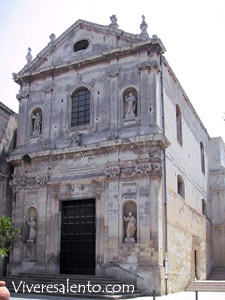 paintings
such as that representing St Anthony of Padua by Oronzo Tiso. The medieval
Church of the St Nicolò and Cataldo was built for the King Tancredi in 1180. The
old portal is very refined and also the rose window dating to the Norman period.
The Church of Saint Maria of the Graces dates to 1590 and was conceived by
Michele Coluccio. It is aisleless, has a beautiful portal, a wooden crucifix by
Vespasiano Genuino, the painting of Our Lady of the Assumption and that of St
Michael Archangel. The chapel of St Mark was built in the 16th century, it has
been desecrated and nowadays there are the offices of a private association. The
church of St Anthony of the Square dates to 1566 and was restored in 1765 by the
architect Regina. It is still possible to visit the 16th century portal left.
The church of St Chiara was built in 1429 according to the will of the Bishop
Ammirato and was restored about 1687. Its 17th century altars by Cino are very
interesting. The Church of the Jesus dates to 1574 and has a Latin cross plan.
Inside the tourist can admire the beautiful Baroque altars especially the high
altar by Cino, beautiful and refined paintings and a wooden 18th century choir.
The church of St Matteo was designed by the architect Larducci and finished by
the Zimbalo. Inside there are the statues of the paintings
such as that representing St Anthony of Padua by Oronzo Tiso. The medieval
Church of the St Nicolò and Cataldo was built for the King Tancredi in 1180. The
old portal is very refined and also the rose window dating to the Norman period.
The Church of Saint Maria of the Graces dates to 1590 and was conceived by
Michele Coluccio. It is aisleless, has a beautiful portal, a wooden crucifix by
Vespasiano Genuino, the painting of Our Lady of the Assumption and that of St
Michael Archangel. The chapel of St Mark was built in the 16th century, it has
been desecrated and nowadays there are the offices of a private association. The
church of St Anthony of the Square dates to 1566 and was restored in 1765 by the
architect Regina. It is still possible to visit the 16th century portal left.
The church of St Chiara was built in 1429 according to the will of the Bishop
Ammirato and was restored about 1687. Its 17th century altars by Cino are very
interesting. The Church of the Jesus dates to 1574 and has a Latin cross plan.
Inside the tourist can admire the beautiful Baroque altars especially the high
altar by Cino, beautiful and refined paintings and a wooden 18th century choir.
The church of St Matteo was designed by the architect Larducci and finished by
the Zimbalo. Inside there are the statues of the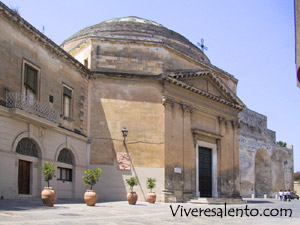 twelve Apostles and sumptuous altars. The church of St Anna was built in the
17th century, is aisleless , has four altars, a wooden ceiling and 17th century
paintings. The church of St Theresa dates to 1620 and was finished by the
Zimbalo too. The façade has three Corinthian columns on both sides of the portal
together with the statues of the Baptist and St John the Evangelist. The church
of the Rosary is the last work of the Zimbalo. It has a Greek cross plan and a
pulpit unique in its style and thoroughly carved in our local stone. The Church
of the Carmine and the Convent of the Carmelites were designed by Cino and their
works began in 1714 and was finished by Manieri. The church of the Angel dates
to the 17th century was built by Zimbalo and belonged to the Augustinians. The
beautiful door in its splendid portal was created by Manieri and made by wise
artisans in 1750. The Church of
twelve Apostles and sumptuous altars. The church of St Anna was built in the
17th century, is aisleless , has four altars, a wooden ceiling and 17th century
paintings. The church of St Theresa dates to 1620 and was finished by the
Zimbalo too. The façade has three Corinthian columns on both sides of the portal
together with the statues of the Baptist and St John the Evangelist. The church
of the Rosary is the last work of the Zimbalo. It has a Greek cross plan and a
pulpit unique in its style and thoroughly carved in our local stone. The Church
of the Carmine and the Convent of the Carmelites were designed by Cino and their
works began in 1714 and was finished by Manieri. The church of the Angel dates
to the 17th century was built by Zimbalo and belonged to the Augustinians. The
beautiful door in its splendid portal was created by Manieri and made by wise
artisans in 1750. The Church of
 St.
Nicolò of the Greek, usually called Greek Church, dates to 1765, here used to
came those who followed the Greek-Byzantine rite. The church of St Mary of the
Providence was began in 1703 but were resumed only in 1724 by Manieri. The
church of St Mary of the Angels, built in 16th century, has a nave and two
aisles. The painting of the ‘Introduction in the Temple’ and ‘the Slaughter of
the Innocent ones’ are very interesting. There are also several interesting
villas in baroque style such as Villa Minerva, Villa Indraccolo, Villa
Apollonio, Villa Bodin and so on. In the past times the patron saint of Lecce
was St Irene but after the miracles of St Oronzo, who helped the population
against the plague of 1656, he was chosen as the new patron saint and is
celebrated on August. St.
Nicolò of the Greek, usually called Greek Church, dates to 1765, here used to
came those who followed the Greek-Byzantine rite. The church of St Mary of the
Providence was began in 1703 but were resumed only in 1724 by Manieri. The
church of St Mary of the Angels, built in 16th century, has a nave and two
aisles. The painting of the ‘Introduction in the Temple’ and ‘the Slaughter of
the Innocent ones’ are very interesting. There are also several interesting
villas in baroque style such as Villa Minerva, Villa Indraccolo, Villa
Apollonio, Villa Bodin and so on. In the past times the patron saint of Lecce
was St Irene but after the miracles of St Oronzo, who helped the population
against the plague of 1656, he was chosen as the new patron saint and is
celebrated on August.
|